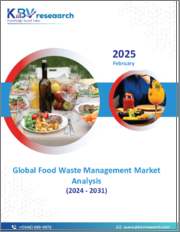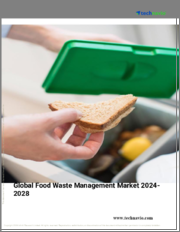
|
시장보고서
상품코드
1622617
세계의 식품 폐기물 관리 시장 규모 : 폐기물 유형별, 폐기물 관리 방법별, 최종 사용자 산업별, 지역별, 범위 및 예측Global Food Waste Management Market Size By Waste Type, By Waste Management Method, By End-User Industry, By Geographic Scope And Forecast |
||||||
식품 폐기물 관리 시장 규모 및 예측
식품 폐기물 관리 시장 규모는 2024년에 421억 5,000만 달러로 평가되었고, 2024년부터 2031년까지 4.65%의 연평균 복합 성장률(CAGR)을 나타낼 전망이며, 2031년에는 606억 4,000만 달러에 도달할 것으로 예상됩니다. 식품 폐기물 관리 시장에는 식품 제조, 소매, 환대, 주택 등 다양한 분야에서 발생하는 식품 폐기물의 삭감, 재활용, 효과적인 관리를 목적으로 한 다양한 전략, 기술, 서비스가 포함됩니다. 여기에는 퇴비화, 혐기성 소화, 폐기물의 에너지 변환, 잉여 식품의 재분배 등의 솔루션이 포함되어 환경 영향을 최소화하고 자원 이용을 최적화하며 식품 폐기에 관한 사회적 우려에 대처합니다.
세계 식품 폐기물 관리 시장 성장 촉진요인
식품 폐기물 관리 시장 시장 성장 촉진요인은 다양한 요인에 의해 영향을 받을 수 있습니다.
환경에 대한 우려 :
환경 문제에 대한 우려 : 식품 폐기물 관리 시스템의 채택은 기후 변화를 포함한 환경 문제에 대한 인식 증가와 식품 폐기물의 환경 풋 프린트의 크기에 의해 추진되고 있습니다. 정부 및 기업은 지속 가능성 장려와 폐기물 감축에 더욱 힘을 쏟고 있습니다.
규제 압력 :
식품 폐기물을 줄이고 지속 가능한 폐기물 관리 기술을 촉진하기 위해 세계 정부가 법률과 정책을 시행하고 있습니다. 이러한 법률에는 재활용이나 쓰레기 삭감의 목표가 내걸려 있는 것이 많아, 식품 폐기물 관리 솔루션의 이용을 기업에 재촉하고 있습니다.
경제적 인센티브 :
식품 공급망 전체의 기업이 식품 폐기의 결과로 큰 경제적 손실을 입고 있습니다. 식품 폐기물을 회수하여 재사용함으로써 기업은 새로운 수입원을 창출할 수 있고, 또한 효율적인 식품 폐기물 관리 절차를 도입함으로써 쓰레기 처리 비용을 절감할 수도 있습니다.
도시화의 진전 및 라이프 스타일의 변화 :
도시화의 진전과 소비자의 라이프 스타일의 변화에 의해 식품에 대한 수요가 높아져 식품 폐기물의 수준이 상승하고 있습니다. 식품 폐기물 관리 솔루션은, 이러한 동향의 결과, 특히 쓰레기 관리의 인프라가 빈번히 스트레스 하에 놓여 있는 도시지역에서 수요가 높아지고 있습니다.
기술 개발 :
식품 폐기물을 보다 효과적이고 효율적으로 관리하는 방법은 머신러닝, 데이터 분석 및 사물 인터넷 센서와 같은 기술 개발을 통해 가능해지고 있습니다. 이러한 툴은, 기업이 개선해야 할 분야를 특정해, 식품 폐기물을 보다 효과적으로 감시 및 관리해, 자원을 최대한으로 활용하는 것을 지원합니다.
기업의 사회적 책임(CSR) :
사회적 및 환경적 책임에 대한 헌신을 보여주기 위해 많은 기업들이 지속가능성과 식품 폐기물 감소 프로그램을 CSR 계획에 통합하고 있습니다. 식품 폐기물 관리 기술에 대한 투자는, 많은 업계에서 이러한 지속 가능성의 중시에 의해서 추진되고 있습니다.
소비자 지식과 수요 :
소비자가 식품 폐기물 문제에 대한 지식을 깊게 하고 지속 가능한 제품과 관행을 요구하게 됨으로써 기업은 식품 폐기물의 삭감과 관리를 최우선 사항으로 하는 영향을 받고 있습니다. 이를 통해 회사는 공급망의 모든 단계에서 폐기물을 줄이기 위한 조치를 취하여 이러한 노력에 대해 고객에게 알릴 수 있습니다.
세계 식품 폐기물 관리 시장 성장 억제요인
식품 폐기물 관리 시장에서는 몇 가지 요인이 억제요인과 과제로 작용할 수 있습니다.
인프라 과제 :
폐기물 관리 인프라의 부족은 많은 지역, 특히 개발 도상국에서 중요한 문제입니다. 쓰레기의 수집, 치료, 재활용의 인프라가 불충분하면, 식품 폐기물의 효과적인 처리를 방해받을 가능성이 있습니다.
고액의 초기 비용 :
식품 폐기물 관리 솔루션을 실용화하기 위해서는 기술, 설비, 직원 연수에 상당한 선행 투자가 필요한 경우가 많습니다. 이러한 비용은 소규모 기업이나 예산이 어려운 기업에서의 채용을 방해할 가능성이 있습니다.
교육과 지식의 부족 :
식품 폐기 문제에 대한 일반 시민의 지식은 높아지고 있는 것, 기업, 소비자, 입법자는 폐기물 관리의 문제 범위나 실행 가능한 해결책을 아직 충분히 이해하고 있지 않습니다. 아웃리치 및 교육 프로그램이 불충분하면, 식품 폐기물 삭감의 대처가 저해될 가능성이 있습니다.
규정의 복잡성 :
기업은 식품 폐기물 감소를 목표로 하는 법률 및 정책에 따라 폐기물 관리 실천을 장려할 수 있지만, 복잡한 규제 프레임워크를 협상하는 것은 어려울 수 있습니다. 기업에 있어서의 참가 장해는, 다양한 규제를 준수할 필요성으로부터 발생할 가능성이 있고, 그 규제 중에는, 관할 구역이 다르면 서로 모순되는 것도 있습니다.
기술적 제약 :
새로운 기술 개발은 식품 폐기물 관리 절차를 강화할 기회를 제공하지만 고려해야 할 단점도 있습니다. 일부 기업은 데이터 분석 또는 사물 인터넷 센서와 같은 최첨단 기술을 채택하기위한 자원이나 접근이 부족할 수 있어 식품 폐기물 관리가 어려워집니다.
문화적 및 행동적 요인 :
지역이나 인구에 따라서는 문화적 규범, 소비자 행동, 식품 폐기에 대한 사고방식에 큰 차이가 있을지도 모릅니다. 식품 폐기를 둘러싼 깊이 뿌리내린 태도나 행동을 고치려면, 끈질긴 교육과 의식 향상에의 대처가 필요할지도 모릅니다.
공급망의 복잡성 :
세계의 식품 공급망에는 생산자부터 소비자에 이르기까지 많은 관계자가 관여하고 있습니다. 특히 부패하기 쉬운 품목이나 다양한 유통 방법을 취급하는 경우에는 공급망 폐기 감축 이니셔티브를 조정하는 것이 어려운 경우가 있습니다.
경제 불확실성 :
식품 폐기물 관리 솔루션에 대한 투자에 대한 기업의 의욕은 경기 침체와 상품 가격 변동에 의해 영향을 받을 수 있습니다. 조직은 재정적으로 어려운 시기에는 장기적인 지속 가능성 노력보다 단기적인 비용 절감책을 우선시할 가능성이 있습니다.
목차
제1장 서론
- 시장의 정의
- 시장 세분화
- 조사 방법
제2장 주요 요약
- 주요 조사 결과
- 시장 개요
- 시장 하이라이트
제3장 시장 개요
- 시장 규모와 성장 가능성
- 시장 동향
- 시장 성장 촉진요인
- 시장 성장 억제요인
- 시장 기회
- Porter's Five Forces 분석
제4장 식품 폐기물 관리 시장 : 폐기물 유형별
- 유기폐기물
- 무기 폐기물
- 포장 폐기물
제5장 식품 폐기물 관리 시장 : 폐기물 관리 방법별
- 매립
- 소각
- 퇴비화
- 혐기성 소화
제6장 식품 폐기물 관리 시장 : 최종 사용자 산업별
- 식품 제조업체
- 푸드서비스 제공업체
- 소매업체
- 식품유통 및 물류
제7장 지역별 분석
- 북미
- 미국
- 캐나다
- 멕시코
- 유럽
- 영국
- 독일
- 프랑스
- 이탈리아
- 아시아태평양
- 중국
- 일본
- 인도
- 호주
- 라틴아메리카
- 브라질
- 아르헨티나
- 칠레
- 중동 및 아프리카
- 남아프리카
- 사우디아라비아
- 아랍에미리트(UAE)
제8장 시장 역학
- 시장 성장 촉진요인
- 시장 성장 억제요인
- 시장 기회
- 시장에 대한 COVID-19의 영향
제9장 경쟁 구도
- 주요 기업
- 시장 점유율 분석
제10장 기업 프로파일
- Veolia Environnement
- Suez
- Waste Management Inc
- FCC Environment Ltd
- Remondis SE & Co KG
- Republic Services Inc
- Covanta Holding Corporation
- Waste Connections Inc
- Clean Harbors Inc
- Stericycle Inc
제11장 시장 전망 및 기회
- 신흥 기술
- 향후 시장 동향
- 투자 기회
제12장 부록
- 약어 목록
- 출처 및 참고문헌
Food Waste Management Market Size And Forecast
Food Waste Management Market size was valued at USD 42.15 Billion in 2024 and is projected to reach USD 60.64 Billion by 2031 , growing at a CAGR of 4.65% during the forecast period 2024-2031 . The Food Waste Management Market encompasses the various strategies, technologies, and services aimed at reducing, recycling, and effectively managing food waste generated across different sectors including food manufacturing, retail, hospitality, and residential. It includes solutions such as composting, anaerobic digestion, waste-to-energy conversion, and redistribution of surplus food to minimize environmental impact, optimize resource utilization, and address societal concerns regarding food wastage.
Global Food Waste Management Market Drivers
The market drivers for the Food Waste Management Market can be influenced by various factors. These may include:
Environmental Concerns:
The adoption of food waste management systems is being driven by a growing awareness of environmental issues, including climate change, and the substantial environmental footprint of food waste. Governments and businesses are concentrating more on encouraging sustainability and cutting waste.
Regulatory Pressures:
To reduce food waste and promote sustainable waste management techniques, governments all over the world are putting laws and policies into effect. These laws frequently have goals for recycling and trash reduction, which encourages firms to use food waste management solutions
Economic Incentives:
Businesses across the food supply chain suffer large financial losses as a result of food waste. By recovering and reusing food waste, companies can possibly generate new revenue streams while also cutting trash disposal expenses by putting into place efficient food waste management procedures.
Growing Urbanisation and Shifting Lifestyles:
As a result of rising urbanisation and shifting consumer habits, there is a greater demand for food, which raises food waste levels. Food waste management solutions are in high demand as a result of this trend, especially in urban areas where the infrastructure for managing garbage is frequently under stress.
Technological Developments:
More effective and efficient methods of managing food waste are being made possible by developments in technology, including machine learning, data analytics, and Internet of Things sensors. These tools assist companies in identifying areas for improvement, monitoring and managing food waste more effectively, and making the most use of their resources.
Corporate Social Responsibility (CSR):
To show their dedication to social and environmental responsibility, many businesses are integrating sustainability and food waste reduction programes into their CSR plans. Investments in food waste management technologies are being driven by this emphasis on sustainability in a number of industries.
Consumer knowledge and Demand:
Businesses are being influenced to give food waste reduction and management top priority by consumers' growing knowledge of food waste issues and their demand for sustainable products and practices. In response, businesses are putting measures into place to reduce waste at every stage of the supply chain and informing customers about these initiatives.
Global Food Waste Management Market Restraints
Several factors can act as restraints or challenges for the Food Waste Management Market. These may include:
Infrastructure Challenges:
Inadequate waste management infrastructure is a major problem in many areas, particularly in developing nations. Inadequate availability of trash collection, treatment, and recycling infrastructure can impede the effective handling of food waste.
High Upfront Expenses:
Putting food waste management solutions into practice frequently necessitates a large upfront investment in technology, equipment, and employee training. These expenses may prevent adoption in smaller companies or ones with tighter budgets.
Lack of Education and knowledge:
Although public knowledge of food waste issues is growing, businesses, consumers, and legislators still do not fully comprehend the scope of the issue or workable solutions for waste management. Inadequate outreach and education programmes can obstruct efforts to reduce food waste.
Regulatory Complexity:
Businesses may be encouraged to implement waste management practices by laws and policies targeted at decreasing food waste, but negotiating complicated regulatory frameworks can be difficult. Entry obstacles for firms might arise from the need to comply with various regulations, some of which may be contradictory with one another across different jurisdictions.
Technological Restrictions:
While new developments in technology present chances to enhance food waste management procedures, there are drawbacks to take into account. It's possible that some firms lack the resources or access to adopt cutting-edge technologies like data analytics or Internet of Things sensors, which makes it more difficult for them to control food waste.
Cultural and Behavioural Factors:
Depending on the region and population, there might be a big difference in cultural norms, consumer behaviours, and attitudes towards food waste. It might take persistent education and awareness initiatives to alter deeply rooted attitudes and behaviours around food waste.
Complexity of the Supply Chain:
There are many parties involved in the global food supply chain, from producers to consumers. It can be difficult to coordinate supply chain waste reduction initiatives, especially when handling perishable items and a variety of distribution methods.
Economic Uncertainty:
Businesses' desire to invest in food waste management solutions may be impacted by downturns in the economy or changes in the price of commodities. Organisations may give priority to short-term cost-cutting measures over longer-term sustainability initiatives during financially difficult times.
Global Food Waste Management Market Segmentation Analysis
Global Food Waste Management Market is segmented based on Waste Type, Waste Management Method, End-User Industry, and Geography.
Food Waste Management Market, By Waste Type
- Organic Waste:
- Biodegradable materials derived from plants or animals, such as food scraps and yard waste.
- Inorganic Waste:
- Non-biodegradable materials like plastics, metals, and glass, commonly found in packaging and other non-food items.
- Packaging Waste:
- Materials used for containment and protection of goods, including cardboard, plastic containers, and packaging films.
Food Waste Management Market, By Waste Management Method
- Landfill:
- Disposal of waste in designated sites, where it is buried underground.
- Incineration:
- Burning waste at high temperatures, converting it into ash, gas, and heat energy.
- Composting:
- Natural decomposition of organic waste into nutrient-rich soil amendment.
- Anaerobic Digestion:
- Biological process breaking down organic waste into biogas and digestate, utilized for renewable energy production and fertilizer.
Food Waste Management Market, By End-User Industry
- Food Manufacturers:
- Companies generating waste during food processing and production operations.
- Food Service Providers (Restaurants, Hotels, Cafeterias):
- Businesses producing food waste from kitchen operations and customer leftovers.
- Retailers (Supermarkets, Grocery Stores):
- Entities with waste from unsold products, damaged goods, and expired inventory.
- Food Distribution & Logistics:
- Companies handling perishable goods during transportation, storage, and delivery.
Food Waste Management Market, By Geography
- North America:
- Market conditions and demand in the United States, Canada, and Mexico.
- Europe:
- Analysis of the Food Waste Management Market in European countries.
- Asia-Pacific:
- Focusing on countries like China, India, Japan, South Korea, and others.
- Middle East and Africa:
- Examining market dynamics in the Middle East and African regions.
- Latin America:
- Covering market trends and developments in countries across Latin America.
Key Players
- The major players in the Food Waste Management Market are:
- Veolia Environnement
- Suez
- Waste Management Inc
- FCC Environment Ltd
- Remondis SE & Co KG
- Republic Services Inc
- Covanta Holding Corporation
- Waste Connections Inc
- Clean Harbors Inc
- Stericycle Inc
TABLE OF CONTENTS
1. Introduction
- Market Definition
- Market Segmentation
- Research Methodology
2. Executive Summary
- Key Findings
- Market Overview
- Market Highlights
3. Market Overview
- Market Size and Growth Potential
- Market Trends
- Market Drivers
- Market Restraints
- Market Opportunities
- Porter's Five Forces Analysis
4. Food Waste Management Market, By Waste Type
- Organic Waste
- Inorganic Waste
- Packaging Waste
5. Food Waste Management Market, By Waste Management Method
- Landfill
- Incineration
- Composting
- Anaerobic Digestion
6. Food Waste Management Market, By End-User Industry
- Food Manufacturers
- Food Service Providers
- Retailers
- Food Distribution & Logistics
7. Regional Analysis
- North America
- United States
- Canada
- Mexico
- Europe
- United Kingdom
- Germany
- France
- Italy
- Asia-Pacific
- China
- Japan
- India
- Australia
- Latin America
- Brazil
- Argentina
- Chile
- Middle East and Africa
- South Africa
- Saudi Arabia
- UAE
8. Market Dynamics
- Market Drivers
- Market Restraints
- Market Opportunities
- Impact of COVID-19 on the Market
9. Competitive Landscape
- Key Players
- Market Share Analysis
10. Company Profiles
- Veolia Environnement
- Suez
- Waste Management Inc
- FCC Environment Ltd
- Remondis SE & Co KG
- Republic Services Inc
- Covanta Holding Corporation
- Waste Connections Inc
- Clean Harbors Inc
- Stericycle Inc
11. Market Outlook and Opportunities
- Emerging Technologies
- Future Market Trends
- Investment Opportunities
12. Appendix
- List of Abbreviations
- Sources and References



















